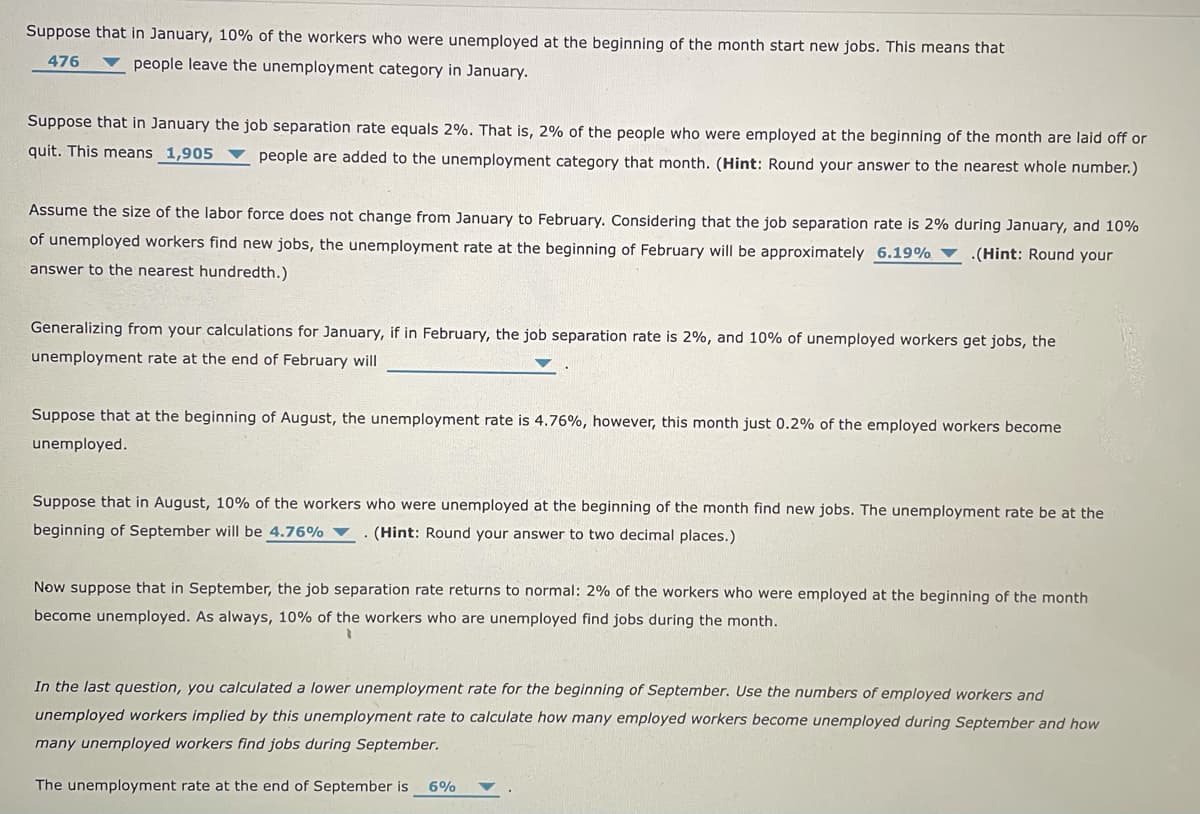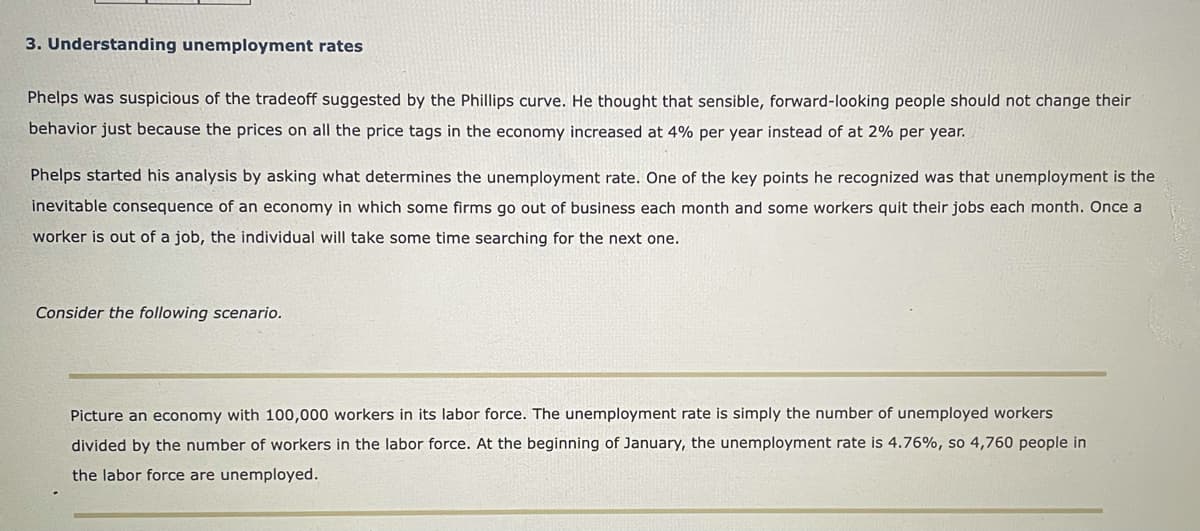Suppose that in January, 10% of the workers who were unemployed at the beginning of the month start new jobs. This means that 476 people leave the unemployment category in January. Suppose that in January the job separation rate equals 2%. That is, 2% of the people who were employed at the beginning of the month are laid off or quit. This means 1,905 ▼ people are added to the unemployment category that month. (Hint: Round your answer to the nearest whole number.) Assume the size of the labor force does not change from January to February. Considering that the job separation rate is 2% during January, and 10% of unemployed workers find new jobs, the unemployment rate at the beginning of February will be approximately 6.19% ▼ .(Hint: Round your answer to the nearest hundredth.)
Suppose that in January, 10% of the workers who were unemployed at the beginning of the month start new jobs. This means that 476 people leave the unemployment category in January. Suppose that in January the job separation rate equals 2%. That is, 2% of the people who were employed at the beginning of the month are laid off or quit. This means 1,905 ▼ people are added to the unemployment category that month. (Hint: Round your answer to the nearest whole number.) Assume the size of the labor force does not change from January to February. Considering that the job separation rate is 2% during January, and 10% of unemployed workers find new jobs, the unemployment rate at the beginning of February will be approximately 6.19% ▼ .(Hint: Round your answer to the nearest hundredth.)
Brief Principles of Macroeconomics (MindTap Course List)
8th Edition
ISBN:9781337091985
Author:N. Gregory Mankiw
Publisher:N. Gregory Mankiw
Chapter12: Money Growth And Intlation
Section: Chapter Questions
Problem 5PA
Related questions
Question

Transcribed Image Text:Suppose that in January, 10% of the workers who were unemployed at the beginning of the month start new jobs. This means that
476
v people leave the unemployment category in January.
Suppose that in January the job separation rate equals 2%. That is, 2% of the people who were employed at the beginning of the month are laid off or
quit. This means 1,905 ▼ people are added to the unemployment category that month. (Hint: Round your answer to the nearest whole number.)
Assume the size of the labor force does not change from January to February. Considering that the job separation rate is 2% during January, and 10%
of unemployed workers find new jobs, the unemployment rate at the beginning of February will be approximately 6.19% ▼
.(Hint: Round your
answer to the nearest hundredth.)
Generalizing from your calculations for January, if in February, the job separation rate is 2%, and 10% of unemployed workers get jobs, the
unemployment rate at the end of February will
Suppose that at the beginning of August, the unemployment rate is 4.76%, however, this month just 0.2% of the employed workers become
unemployed.
Suppose that in August, 10% of the workers who were unemployed at the beginning of the month find new jobs. The unemployment rate be at the
beginning of September will be 4.76% ▼
(Hint: Round your answer to two decimal places.)
Now suppose that in September, the job separation rate returns to normal: 2% of the workers who were employed at the beginning of the month
become unemployed. As always, 10% of the workers who are unemployed find jobs during the month.
In the last question, you calculated a lower unemployment rate for the beginning of September. Use the numbers of employed workers and
unemployed workers implied by this unemployment rate to calculate how many employed workers become unemployed during September and how
many unemployed workers find jobs during September.
The unemployment rate at the end of September is
6%

Transcribed Image Text:3. Understanding unemployment rates
Phelps was suspicious of the tradeoff suggested by the Phillips curve. He thought that sensible, forward-looking people should not change their
behavior just because the prices on all the price tags in the economy increased at 4% per year instead of at 2% per year.
Phelps started his analysis by asking what determines the unemployment rate. One of the key points he recognized was that unemployment is the
inevitable consequence of an economy in which some firms go out of business each month and some workers quit their jobs each month. Once a
worker is out of a job, the individual will take some time searching for the next one.
Consider the following scenario.
Picture an economy with 100,000 workers in its labor force. The unemployment rate is simply the number of unemployed workers
divided by the number of workers in the labor force. At the beginning of January, the unemployment rate is 4.76%, so 4,760 people in
the labor force are unemployed.
Expert Solution
This question has been solved!
Explore an expertly crafted, step-by-step solution for a thorough understanding of key concepts.
This is a popular solution!
Trending now
This is a popular solution!
Step by step
Solved in 4 steps

Knowledge Booster
Learn more about
Need a deep-dive on the concept behind this application? Look no further. Learn more about this topic, economics and related others by exploring similar questions and additional content below.Recommended textbooks for you

Brief Principles of Macroeconomics (MindTap Cours…
Economics
ISBN:
9781337091985
Author:
N. Gregory Mankiw
Publisher:
Cengage Learning

Essentials of Economics (MindTap Course List)
Economics
ISBN:
9781337091992
Author:
N. Gregory Mankiw
Publisher:
Cengage Learning

Principles of Economics 2e
Economics
ISBN:
9781947172364
Author:
Steven A. Greenlaw; David Shapiro
Publisher:
OpenStax

Brief Principles of Macroeconomics (MindTap Cours…
Economics
ISBN:
9781337091985
Author:
N. Gregory Mankiw
Publisher:
Cengage Learning

Essentials of Economics (MindTap Course List)
Economics
ISBN:
9781337091992
Author:
N. Gregory Mankiw
Publisher:
Cengage Learning

Principles of Economics 2e
Economics
ISBN:
9781947172364
Author:
Steven A. Greenlaw; David Shapiro
Publisher:
OpenStax

Principles of Economics (MindTap Course List)
Economics
ISBN:
9781305585126
Author:
N. Gregory Mankiw
Publisher:
Cengage Learning

Principles of Economics, 7th Edition (MindTap Cou…
Economics
ISBN:
9781285165875
Author:
N. Gregory Mankiw
Publisher:
Cengage Learning

Principles of Macroeconomics (MindTap Course List)
Economics
ISBN:
9781285165912
Author:
N. Gregory Mankiw
Publisher:
Cengage Learning